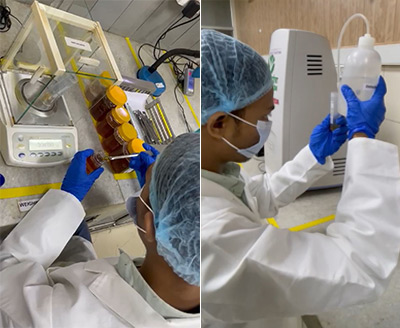
In its simplest form, pure honey is gently filtered with nothing at all being added to the honey. No sweeteners, preservatives or flavours. Honey gets its flavour from nature, from the pollen in the local flowers and plants that the bees forage on. Honey will be unique and will depend on the environment the flowers (and bees).
Our honey is not adulterated in any form this is ensured by testing each batch of the Honey we procure. Every drop you consume is 100% pure as every drop of honey we source is directly for the beekeepers and is tested for authenticity in our in house lab and fruther sent to Germany for testing adulteration.
Honey purity tests conducted in the laboratory-
| S.no |
Test |
Description |
| 1 | Pollen test | This test counts the amount of pollen present in the honey that can help predict the botanical origin of honey. |
| 2 | Electrical conductivity test | The electrical conductivity of 20 gm honey dissolved in 100 ml water should be around 0.8 mS/cm. |
| 3 | Hydroxymethylfurfural (HMF) | The levels of HMF indicate the freshness of honey. Lower the HMF value, the fresher the honey. |
| 4 | Liquid chromatography isotopic ratio mass spectrometry (LC-IRMS) | This test calculates the deviations between δ 13C values. The test helps in calculating C4 sugars and foreign oligosaccharides. |
| 5 | Liquid chromatography and high-resolution mass spectrum (LC-HRMS) | This test helps in identification of artificial sugar syrups like synthetic syrups, C3 and C4 sugar syrups. |
| 6 | Proline quantity | Proline is an essential indicator of the quality of honey. Proline value less than 180 mg indicates adulteration. |
| 7 | TMR and SMR | These tests are done to detect rice syrup adulteration by identifying trace or specific marker for rice syrup |
Antibiotic test
 Antibiotic residues have toxic acute and chronic effects on human health and also reduce the efficacy and quality of honey. This review was conducted aiming to evaluate the tetracyclines (TCs) residues in honey, compared to international standards available in this field. In conclusion, our study demonstrated that a worldwide concerted effort is required to uphold the all-natural, wholesome and clean and green image of honey.
Antibiotic residues have toxic acute and chronic effects on human health and also reduce the efficacy and quality of honey. This review was conducted aiming to evaluate the tetracyclines (TCs) residues in honey, compared to international standards available in this field. In conclusion, our study demonstrated that a worldwide concerted effort is required to uphold the all-natural, wholesome and clean and green image of honey.
Sulfonamide antibiotics are commonly used in veterinary medicine such as for the prevention and treatment of bacterial diseases in bees. However, this can lead to sulfonamide residues in honey. This is of major concern because of possible allergic reactions in sensitive or sensitized people.
C3/C4 analysis (Adulteration test)
 Sugar syrup made from C4 and C3 sugars are direct adulterants which mean they are added directly to the honey to increase its quantity.
Sugar syrup made from C4 and C3 sugars are direct adulterants which mean they are added directly to the honey to increase its quantity.
Both Sugar syrup and honey are sweeteners but differ in health profile: C3 and C4 plants have natural sugar, however, when they are used to make sugar syrup through harsh processing, it becomes toxic.
Sample weighting and HMF sample preparation
An organic compound known as 5-hydroxymethylfurfural (HMF) is formed from reducing sugars in honey and various processed foods in acidic environments when they are heated through the Maillard reaction.
5-hydroxymethylfurfural – An organic compound known as 5-hydroxymethylfurfural (HMF) is formed from reducing sugars in honey and various processed foods in acidic environments when they are heated through the Maillard reaction. In addition to processing, storage conditions affect the formation HMF, and HMF has become a suitable indicator of honey quality.



